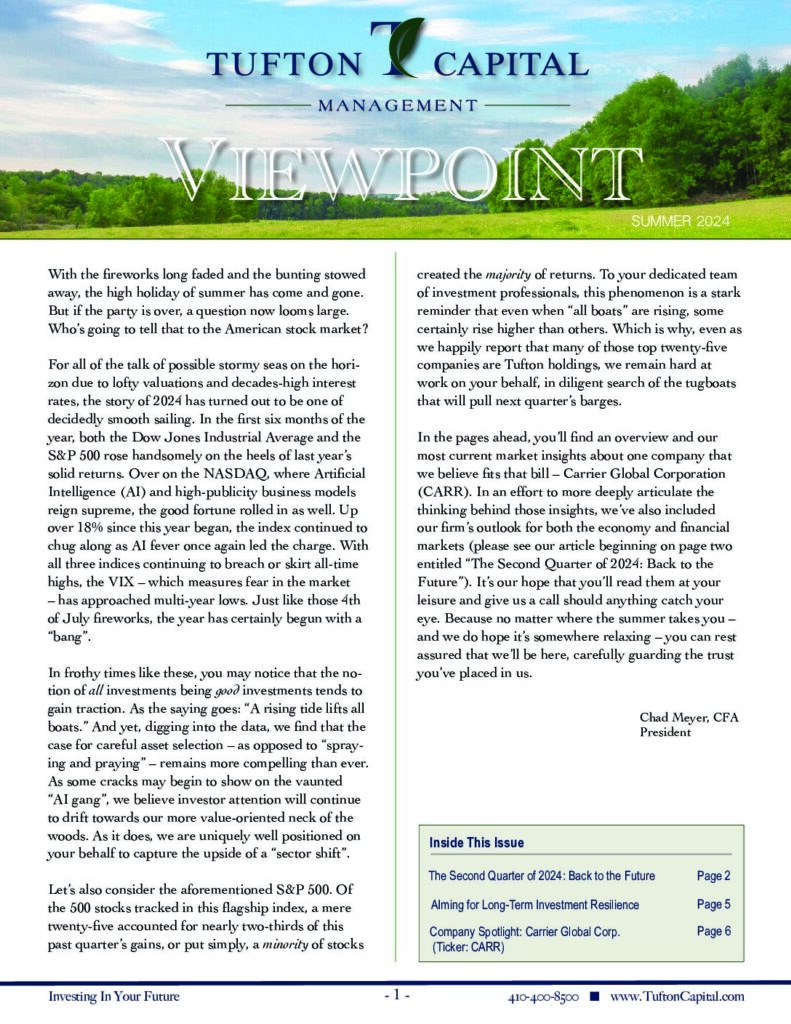 In the third quarter of 2008, the markets experienced the most serious challenge to world financial stability since the depression of the 1930s. What began in early 2007 with a sharp upturn in subprime mortgage delinquencies spread into commercial banks, insurance companies, and investment banking firms. By quarter’s end, the world’s credit markets were in a state of seizure. Investors and borrowers began to lose confidence in our leading financial institutions and volatility reached extremely high levels. In particular, equity prices fell sharply, reacting to seemingly unbelievable developments in the individual financial institutions.
In the third quarter of 2008, the markets experienced the most serious challenge to world financial stability since the depression of the 1930s. What began in early 2007 with a sharp upturn in subprime mortgage delinquencies spread into commercial banks, insurance companies, and investment banking firms. By quarter’s end, the world’s credit markets were in a state of seizure. Investors and borrowers began to lose confidence in our leading financial institutions and volatility reached extremely high levels. In particular, equity prices fell sharply, reacting to seemingly unbelievable developments in the individual financial institutions.
As the quarter came to a close, some of our nation’s largest institutions had either ceased to exist or were in the process of radically changing their business models. Goldman Sachs and Morgan Stanley experienced 40% declines in stock values, in just three days, victims of short-sellers and hedge funds. By the week ended September 19th, Morgan and Goldman announced plans to reorganize as bank holding companies. In a single six-month period, all five of America’s major investment banking firms (Bear Stearns, Merrill Lynch, Lehman Brothers, Goldman Sachs, and Morgan Stanley) either merged with a bank, reorganized, or filed for bankruptcy. The end of America’s leadership in investment banking would have been unthinkable at the start of the third quarter of 2008.
Commercial banks were also swept into the maelstrom. Wachovia Bank’s stock fell from 60 in early 2007, to as low as 10 on September 26, 2008. As deposits fled, Wachovia was forced into a merger with Citigroup, which was announced on September 29th. This followed the merger of Washington Mutual, our nation’s largest thrift, into J. P. Morgan, which had occurred earlier in the same week. As the leading originator of many of the subprime mortgages, Washington Mutual was taken over by the Office of Thrift Supervision and forced to accept merger terms very favorable to J. P. Morgan. Even the old-line banks such as Fifth Third Bank of Cincinnati, National City and KeyCorp (both Cleveland-based banks), and Regions Financial of Birmingham experienced share price declines of 70% or more, frightening investors and depositors. (more…)
 Fear and greed drive markets. In Jim’s letter, he explains how we got to where we are so quickly. But to summarize in a word, it was greed. Greed was everywhere, not just on Wall Street, as the media would like you to think. Greed pushed the price of oil to nearly $150 per barrel. Greed convinced speculators to buy homes they intended on flipping. Greed motivated some home-buyers to “fudge” their mortgage applications. Greed convinced mortgage brokers that credit worthiness really did not matter. Greed inspired banks and brokers to securitize these mortgages. And greed produced the over-leveraged balance sheets loaded with these securities.
Fear and greed drive markets. In Jim’s letter, he explains how we got to where we are so quickly. But to summarize in a word, it was greed. Greed was everywhere, not just on Wall Street, as the media would like you to think. Greed pushed the price of oil to nearly $150 per barrel. Greed convinced speculators to buy homes they intended on flipping. Greed motivated some home-buyers to “fudge” their mortgage applications. Greed convinced mortgage brokers that credit worthiness really did not matter. Greed inspired banks and brokers to securitize these mortgages. And greed produced the over-leveraged balance sheets loaded with these securities.
Now, fear has taken over. Fear forced Bear Stearns into the arms of JP Morgan. Fear brought on the nationalization of Fannie Mae and Freddie Mac. Fear drove AIG, the world’s largest insurer, to the brink of bankruptcy. Fear seized up the credit markets. Fear forced Goldman Sachs and Morgan Stanley to give up their investment banking business models. Fear pummeled stock prices with record force as the volatility index spiked to record levels. Fear is everywhere.
From peak to trough, the stock market has dropped by more than 30% through the first week of October. For investors with a time horizon of anything longer than a year, getting out of the market at this point makes no sense. Most of the pain has been inflicted. Stocks could go lower but clearly a tremendous amount of bad news is already priced into the market. After all of this, a “professional investor” goes on national television and advises people to get out of the market? That should prove to be one of the all-time bad calls ever made. The bigger problem with getting investors out at the bottom is they most likely will not get back in when the market improves. (more…)



